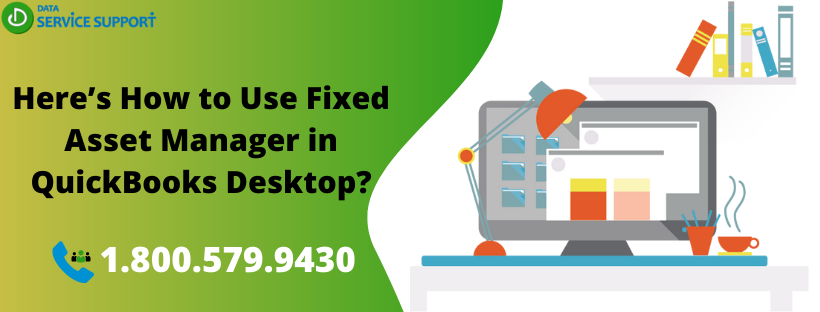Need to learn how to use fixed asset manager in QuickBooks to track your fixed assets? Read this post until the end to get the task done on your own!
Fixed assets of a business are those assets that are purchased for long-term use and are not likely to be converted into cash. These assets may include land, building, equipment, and various others. You can set up and use fixed asset manager in QuickBooks to keep a close account of assets and their depreciation efficiently through an inbuilt automatic process. In this post, we will discuss how to record fixed asset in QuickBooks to keep track of your permanent business assets efficiently.
Now sure how to maintain fixed asset register in QuickBooks? Give us a call on our helpline number (855)-526-5749 to get help from our qualified QB experts
How To Manage Fixed Asset In QuickBooks?
To use fixed asset manager in QuickBooks, you need to follow the below-described steps carefully:
Assign An Account To Multiple Assets
You need to manually assign the accounts to the assets in FAM by following the below-given steps:
- Open Fixed Asset Manager in the first place.
- Next, in the Schedule tab, you need to highlight all the assets that need to be assigned to a specific account.
- After that, right-click the selected asset and then choose Assign G/L Accounts to Assets.
- Select the account and then hit OK to finish.
Modify Or Add The Depreciation Setting
To handle fixed assets in QuickBooks accurately, you may need to change or add the depreciation method, so that FAM can calculate the current and prior depreciation correctly.
- Launch FAM and then from within the File menu, select Client Information.
- Now from the Methods tab, select a suitable depreciation method for the depreciation basis.
- Hit OK to confirm the changes you have made.
Depreciate An Old Asset
If your business already has old assets before setting up the FAM, you need to record your fixed assets with correct depreciation.
To Record Depreciation In QuickBooks:
- First of all, choose Fixed Asset Item List from the List menu.
- Now select Item and then further select New.
- Provide the required information and then click OK to exit the New Item window.
Now In FAM:
- Open Asset Synchronization Log window and then click OK.
- Now from the Schedule tab, double-click the asset you have created.
- Next, on the Federal column, move down to the Prior Depreciation row and then select the amount displayed.
- After that, make the required adjustments in AMT, ACE, Book, State and other columns.
Export QuickBooks Fixed Asset Items into ProSeries Form 4562
If you want to export data from QuickBooks Fixed Asset Manager, it should be the same year of ProSeries. The main reason behind this criteria is that QB Desktop is based on Calender year whereas, FAM and ProSeries are based on the Tax year. It means, for QuickBooks 2017, you need FAM 2016 which can export to ProSeries 2016.
Note: Users can only export data from QuickBooks Fixed Asset Manager to the same year of Pro Series because QuickBooks rely on the calendar year while Fixed Asset Manager and Pro Series is based upon taxation year.
Follow the Steps within the Pro Series:
- Create a file using the same form with which you created file in the QuickBooks.
Follow the given Steps in QuickBooks Desktop:
- Creating FAM assets
- Move to the List menu and choose Fixed Asset Item List.
- Click Item and then New.
- Input the Fixed Asset Information and select OK.
- Transfer QuickBooks FAM information to Fixed Asset modules.
- Move to the Accountant menu, choose Manage Fixed Asset.
- Next, select Create a New Fixed Asset Manager client, then click OK and Next.
- Provide the date and click Next.
- Choose the Applicable basis then Next.
- For each basis, choose the Default Depreciation Method and click Next.
- Choose a method for how you want the fixed asset to be brought fixed in Fixed Assets Module from QuickBooks application and click Next.
- Choose the type of asset in QuickBooks to save to Fixed Asset Item List, then click Next.
- In the Asset Synchronization Log, click Finish, then OK.
Follow the Steps in Fixed Asset Manager:
- Get to the File
- Next, select Export, then ProSeries Tax, then Export.
- From the Export ProSeries Tax Client File list, select the file.
- Choose the Client File and click Export.
- Select OK and the message “The export has been completed successfully” will appears on the screen.
Follow the Steps in Pro Series
- When the user opens the client file, the import should show Completed.
- All assets from the QuickBooks Desktop application should be displayed in the asset list of ProSeries Form 4562 Depreciation and Amortization and Asset Entry Worksheets.
Import Fixed Assets From Excel Into The FAM
QuickBooks FAM enables users to import information from third-party applications when these applications can export data as Comma Separated Value (.CSV) file. Follow the below-given steps to use fixed asset manager in QuickBooks import data:
- In the first place, you need to open the Fixed Asset Manager.
- Next, from the File menu, select Import.
- After that, select Comma Separated (CSV) to initiate the Import Wizard.
- Follow the on-screen instructions to complete the import process.
Read More: POS Got Stuck For A Second | Here’s How To Fix?
Need Expert Assistance?
By reading this full post, you can manage fixed asset in QuickBooks efficiently. For any technical help, feel free to dial our helpline number 1.800.579.9430. On connecting, you can explain your doubt or technical unease with our expert. Under the hassle-free assistance of our experts, you can use fixed asset manager in QuickBooks without any technical distress.
